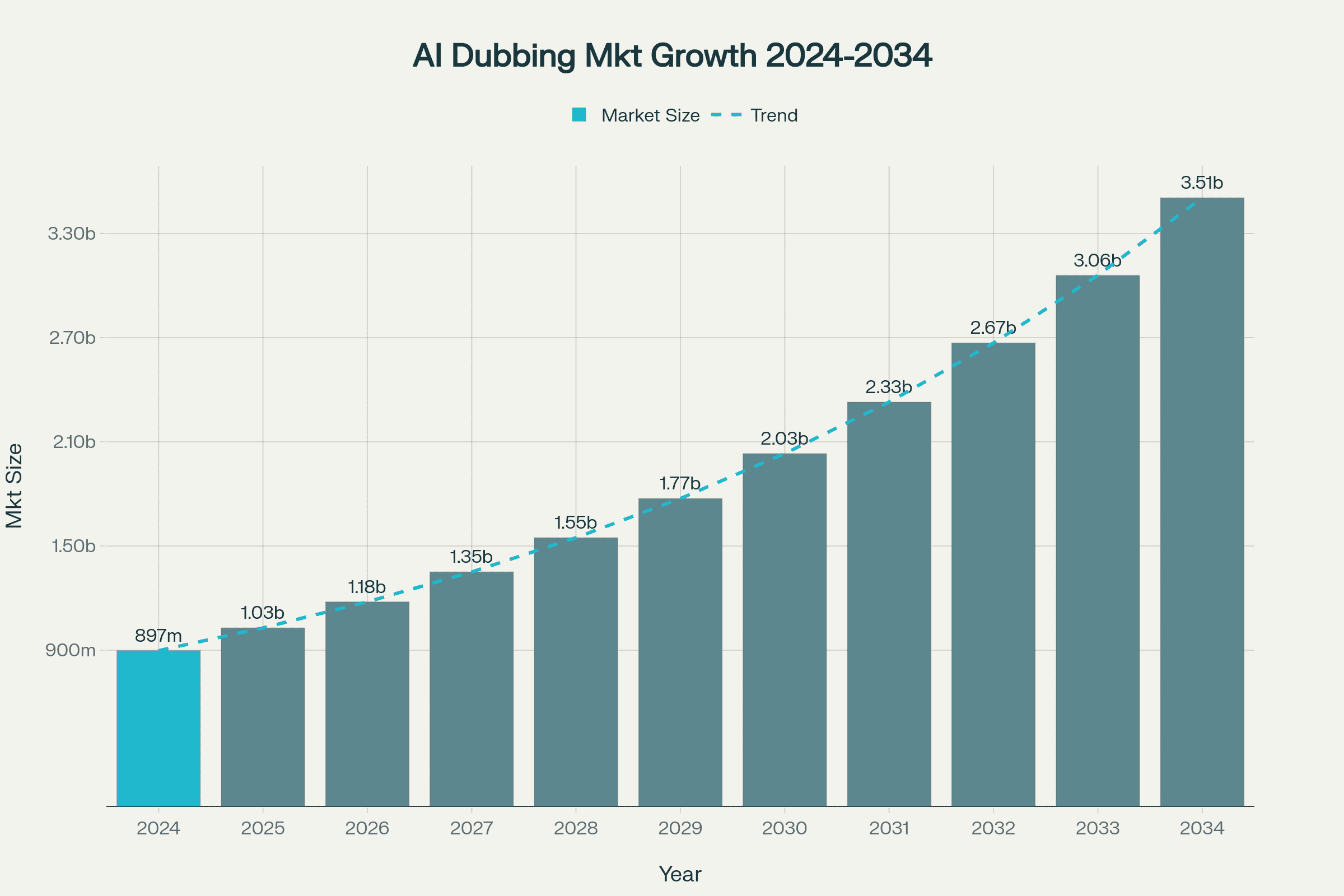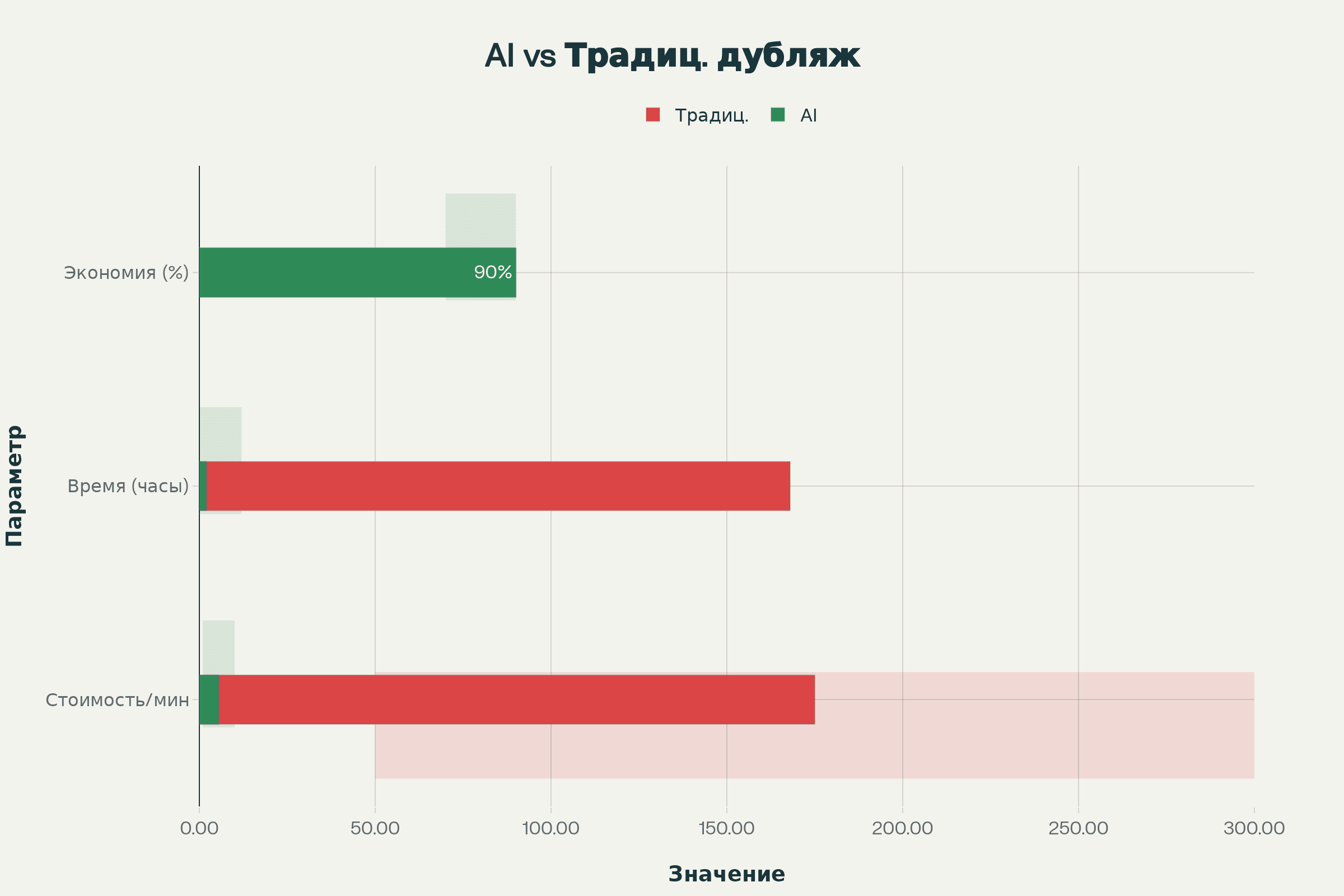Explosive Market Growth: Impressive Numbers
The global AI dubbing market shows remarkable growth dynamics. According to Research and Markets, the market size reached $897.2 million in 2024 and is projected to grow to $3.57 billion by 2034 with a 14.6% CAGR.

This rapid growth is driven by several key factors:
- Growing demand for localized content from streaming platforms expanding their global presence
- Cost efficiency of AI solutions compared to traditional dubbing methods, enabling companies to reduce costs by 60-86% while significantly speeding up production
- Technological breakthroughs in speech synthesis and machine learning, creating voices nearly indistinguishable from humans
Revolutionizing Dubbing Economics
Comparing traditional and AI dubbing reveals fundamental differences in approaches and costs:

Traditional Dubbing:
- Cost: $50-300 per minute of finished content
- Production time: Weeks or months
- Process: Hiring actors, studio rentals, post-production
AI Dubbing:
- Cost: $0.50-10 per minute
- Production time: Minutes or hours
- Process: Fully automated
"The dramatic cost difference between traditional and AI dubbing methods represents a turning point for the industry"
For a standard 90-minute film, traditional dubbing may cost $4,500-$27,000, while AI dubbing would only require $45-900.
Want to accurately calculate the cost of translating your video? A detailed price breakdown of AI dubbing from different services will help you choose the optimal solution.
Compare video translation costs →Real Results 2025: Case Studies from Practice
Educational Platforms: Measurable ROI
Coursera launched AI-dubbed courses in 4 languages in 2025, reaching 800 million speakers of Spanish, French, German, and Portuguese. The results exceeded expectations: students complete translated courses 25% faster than the original English versions. In Mexico, where only 12% speak English proficiently, localized courses opened educational access to 7.3 million learners.
Corporate Training: Budget Savings
A global technology company faced the challenge of localizing 100 training videos lasting 45-60 minutes into 7 languages. Traditional approach would have cost $1 million, but an AI solution with short recap videos reduced costs to $1,500 per video—86% savings. Another company recorded 400% faster employee onboarding after implementing multilingual training materials.
Medical Content: Accessibility and Compliance
YouTube Health launched an AI dubbing pilot in 2024-2025 with Mass General Brigham and JAMA to translate medical educational content into Spanish and Portuguese. Critically important: all translations undergo mandatory review by clinicians, complying with ACA Section 1557 requirements. This expanded access to quality medical information for Spanish-speaking patients and underserved communities while maintaining terminology accuracy.
Streaming Platforms: Global Reach
YouTube rolled out auto-dubbing tools to 3+ million content creators in 2025. The results are impressive: creators with dubbed audio receive 25%+ watch time from non-native language viewers. Jamie Oliver's channel tripled its views after implementing multilingual audio, while Amazon Prime Video launched a pilot on 12 titles, monetizing content that previously lacked dubbing due to traditional methods' high costs.
Technological Foundation: How AI Dubbing Works
Modern AI dubbing systems employ an integrated approach combining several advanced technologies:
Automatic Speech Recognition (ASR)
Neural networks analyze the original audio track, creating accurate transcripts with timestamps.
Machine Translation
Advanced algorithms translate text while considering context, idioms, and cultural aspects of the target language.
Text-to-Speech (TTS)
Modern models generate natural-sounding voices with proper intonation and emotional expression. Quality has reached 95%+ lip-sync alignment accuracy and 90-95% preservation of original emotional tones.
Voice Cloning
This technology recreates unique characteristics of the original speaker's voice in any language. Modern systems create clones from 20-second audio samples, maintaining speaker identity across all language versions.
Lip Sync
AI automatically adjusts speech timing to match on-screen characters' lip movements.
Market Leaders and Innovative Solutions
Russian Players
Speeek.io stands out in the Russian market as a leading AI dubbing service. The platform supports 20+ languages, automatically recognizes individual speakers, and offers voice cloning functionality.
TOP-5 video translation services →
Global Leaders
ElevenLabs raised $180 million in January 2025 at a $3.3 billion valuation. The platform supports 70+ languages with revolutionary Eleven v3 model enabling natural multi-speaker dialogues. In 2024, the company reduced prices by 50%, making the technology even more accessible. 60% of Fortune 500 companies already use ElevenLabs.
Deepdub launched Deepdub Live in April 2025—the first production-ready solution for real-time live content dubbing. The technology is used for sports broadcasts, breaking news, and esports with frame-accurate synchronization.
AI Studios (DeepBrain AI) offers 2,000+ AI avatars and supports 150+ languages, enabling creation of cinematic-quality videos from text prompts. Partnership with NEC led to deployment of AI anchors on Japanese television.
Speechify won the Apple Design Award 2025 for outstanding innovation in accessibility. The platform supports dubbing in 150+ languages with 1,000+ voices and is used by 50+ million users globally.
Applications and Future Prospects
AI dubbing finds applications across diverse sectors:
Streaming Platforms
Prime Video has launched an AI dubbing pilot program for films and series in English and Spanish. Netflix resumed Russian dubbing using AI technologies, processing millions of minutes of content annually.
Education and Corporate Training
Companies use AI dubbing for rapid localization of training materials and corporate presentations. Typical savings amount to 60-86% of budget with 4-10x production acceleration. E-learning localization →
YouTube and Social Media
Content creators gained the ability to scale their audience without significant professional dubbing costs. Creators record 25%+ increase in watch time from international audiences. How influencers reach international audiences →
Medicine and Pharmaceuticals
A special application area—medical educational content, patient education videos, and pharma corporate training. Critically important: medical content requires mandatory review by qualified professionals in accordance with regulatory requirements (ACA Section 1557, FDA guidance).
2025 Technology Trends
- Emotional AI: Models now recognize and reproduce complex emotional nuances with 26 distinct emotions
- Multi-speaker recognition: Systems automatically identify and process multiple speakers
- Real-time processing: Production-ready solutions for live stream dubbing, sports events, and video conferences
- Video editor integration: AI dubbing built into popular editing platforms
- Voice cloning from 20 seconds: Maintaining voice identity across all language versions
Progress and Outlook
Experts predict further acceleration in AI dubbing development:
By 2026:
- Quality improvements reaching human-indistinguishable levels
- Language support expansion to 200+ languages
- Cost reduction to $0.1-1 per minute
By 2030:
- Full automation of localization processes while maintaining quality control
- Integration with AR/VR platforms
- Personalized dubbing for individual users
- AI-generated voices handling 90%+ of scripted audio content
Try Speeek right now
Translate video into 29 languages while preserving your voice and lip sync
Sign up for freeConclusion
AI dubbing in 2025 represents a mature technology that's fundamentally transforming video localization. Up to 86% cost savings, 4-10x production acceleration, and continuously improving quality make this technology indispensable for companies of all sizes.
The key lesson from 2024-2025: most successful implementations use a hybrid approach—AI for speed and volume, human oversight for quality and compliance. Coursera showed 25% improvement in course completion, corporate L&D departments record 400% faster onboarding, and YouTube content creators triple their audience reach.
For the global market, including Russian-speaking segments with services like Speeek, this opens tremendous opportunities to reach international audiences without substantial traditional dubbing investments. Companies not adopting AI technologies now risk falling behind in the rapidly evolving media landscape.
The future of video localization has arrived, and it speaks the language of artificial intelligence.
